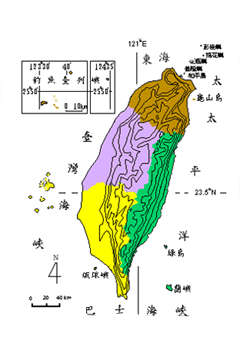The Pedology of Taiwan

Relevant Websites
- Tai-wan-zhu-yao-tu-rang-zhi-fen-bu-yu-te-xing
- Zhong-xue-di-li-jiao-yu-zhong-de-tu-rang-jiao-xue
- Tu-rang-wu-ran-fang-zhi
- Tai-wan-de-nong-tian-tu-rang-yu-li-yong
Reference
- Wang, Ming-kuo and Chao-shen Hsieh, 1988: Tai-wan-di-qu-tu-ran-tu, Council of Agriculture Executive Yuan.
- Wang, Ming-kuo and Chao-shen Hsieh, 1989: Tai-wan-tu-rang (Tai-wan-di-qu 1:250,000 tu-rang-shuo-ming-shu), National Chung Hsing University, pp. 205.
- Hsi, Lien-chih, 1950: Tai-wan-xin-zhi-tu-rang-pian, Zhong-hua-wen-hua-chu-ban-wei-yuan-hui, pp. 121-141.
- Liang, Chu-jung and Chang-yun Chou, 1978: Tai-wan-zhi-tu-rang, Shi-da-di-li-yan-jiu-bao-gao, Vol. 4, pp.1-44.
- Yang, His-fu (et al.), 1950: Tai-wan-xin-zhi-tu-rang-pian, Zhong-hua-wen-hua-chu-ban-wei-yuan-hui, pp. 121-141.
- Liang, Chu-jung and Chen Chen trans., 1957: Soils of Taiwan, Zhong-hua-nong-xue-hui-bao, Vol. 20, pp. 1-26.
- Hsieh, Chueh-ming edit. and Kuo-shui Yao trans., 1970: Tai-wan-bao-dao, Zhong-hua-xue-shu-yuan-zhong-guo-di-xue-yan-jiu-suo, pp. 402.
Soil develops under various influences: its origins and component materials, the local climate, surrounding topography, hydrology and biology, as well as human activities and time. There are ten types of soil in Taiwan. Mountain areas (over 1,000 meters) are covered with lihosol and podzol. Hills (100-1,000 meters) and plateaus (below 100 meters) are capped with reddish-yellow podzol, brown forest soil and yellowish-brown latosol. The plains are covered with reddish-brown latosol, alluvial soil, saline soil, planosol-like soil and regosol.
a. Lihosol
Lihosol is an underdeveloped soil that contains a lot of rubble and lacks a clear structure. Taiwan has extensive mountainous areas, a varied topography and multi-jointed "parent rocks." These features, combined with the frequent rainstorms, have resulted in the wide distribution of lihosol. Mountains over 1,000 meters are covered primarily with lihosol; even on hills as high as 500 meters this kind of soil often appears mixed with other soils.
b. Podzol
Podzol is a regional soil developed beneath the cover of forest and copse in temperate, humid climates. We can find traces of podzol or brown podzol above 1,000 meters in Taiwan.
c. Reddish-yellow podzol
Cultivated in regions which grow tropical or sub-tropical broadleaf trees, reddish-yellow podzol is an acid soil that grows from parent rocks rich in silicon. It is distributed in areas ranging between 100 and 1,000 meters in altitude. Taiwan's reddish-yellow podzol is mainly spread through the piedmonts and hills west of the Central Mountain Range. It sometimes appears with reddish-brown latosol in low plateaus.
d. Brown forest soil
Brown forest soil is found in the piedmonts and hills widely covered by broadleaf trees. It is often mixed with reddish-yellow podzol. We find widespread brown forest soil coverage in the hills in eastern Tainan and Kaohsiung counties.
e. Yellowish-brown latosol
Yellowish-brown latosol is a type of laterite soil. It is plentiful on hills of between 100 and 500 meters in altitude and in the areas north, west, southwest and south of the Central Mountain Range. It sometimes can be found on plateaus, mixed with reddish-brown latosol.
f. Reddish-brown latosol
Reddish brown latosol is another type of laterite soil. It is widely distributed through plateau and river terrace regions in Taiwan. Laterite is generally believed to have existed since the Pleistocence Era, so it is also called "old red soil."
g. Alluvial soil
Alluvial soil is the most common soil in flatlands like Pingtung. Its level of distribution is second only to that of calcareous soil in the mountains. In terms of the soil-forming process, alluvial soil is extremely young since Taiwan's short, fast-flowing rivers keep bringing to it new materials from mountains. Rushing currents also carry broken stones rich in silicon, so alluvial soil is extremely fertile and therefore important for Taiwan's agriculture. After long-term irrigation, part of the alluvial soil has become clay-like soil which is particularly suitable for the planting of rice.
h. Saline soil
Saline soil is formed out of salt so it is found only in the dry seasons on coastal lowlands south of the Choshui River. It is not a productive soil.
i. Planosol-like soil
Planosol-like soil is also named "old alluvial soil" because it has an old layer of solid and sticky alluvial soil as its base. It is mostly found in the Chia-nan and Kaohsiung plains. Due to its sticky foundation, water drainage and air circulation are not good in these regions. Crops and other plants also have difficulty stretching their roots to grow well. This is so-called "Taiwan clay."
j. Regosol
Regosol's parent materials usually come from sand dunes or eluvium (wind-borne deposits) in windy coastal areas. So regosol is a sand-like soil, not productive. Its distribution is rather small; it is found principally in coastal areas such as Ilan's Lotung coast, the Hsin-chu and Miao-li coastal piedmonts, and Tainan and Kaohsiung.